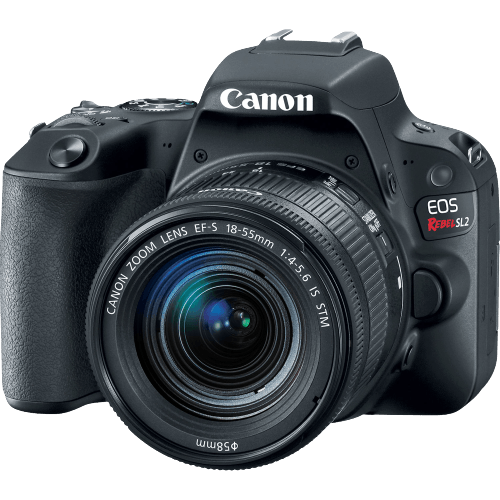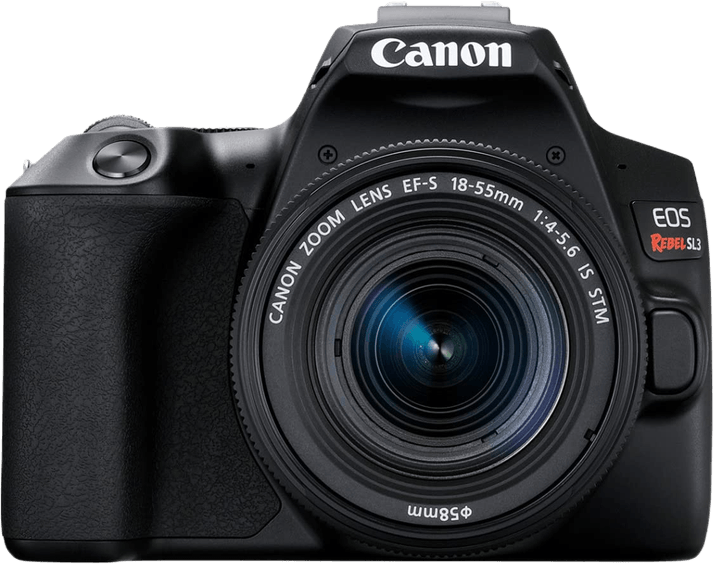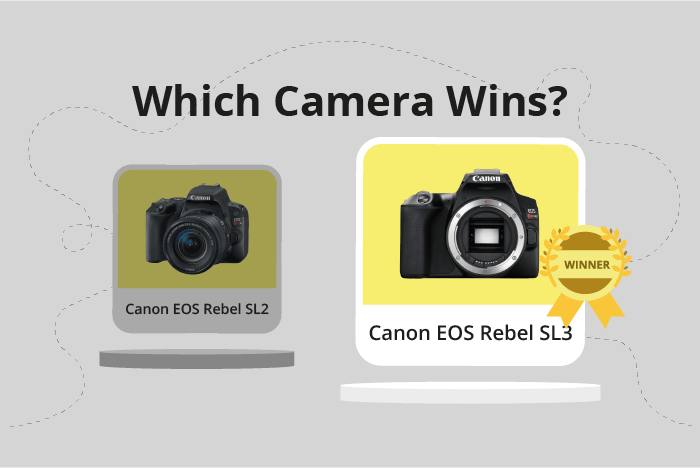Canon EOS Rebel SL2 / 200D vs Rebel EOS SL3 / 250D Comparison
Canon EOS Rebel SL2 / 200D

Canon EOS Rebel SL3 / 250D

The Canon Rebel EOS SL3 / 250D narrowly outperforms the Canon EOS Rebel SL2 / 200D with a score of 63/100 compared to 62/100. Both cameras share several specifications, including being DSLRs, having the same dimensions (122 x 93 x 70mm), and similar launch prices ($599 for the SL3 and $550 for the SL2).
The SL3 is superior to the SL2 due to its more recent release in 2019, two years after the SL2’s 2017 release. This newer model likely incorporates updated technology, contributing to its higher score. However, the SL2 has the advantage of being significantly lighter at 302g (0.67lbs), compared to the SL3’s 449g (0.99lbs). This makes the SL2 more portable and convenient for on-the-go photography.
Taking these factors into account, the Canon Rebel EOS SL3 / 250D is the better camera in general, but the Canon EOS Rebel SL2 / 200D may be more suitable for those prioritizing portability and a lighter weight.
Canon EOS Rebel SL2 / 200D vs Rebel EOS SL3 / 250D Overview and Optics
The Canon EOS Rebel SL2 / 200D narrowly wins in the optics comparison with a score of 62/100, while the Canon Rebel EOS SL3 / 250D trails closely behind with a score of 61/100. Both cameras share several specifications, including a CMOS sensor, APS-C sensor size, and a shooting speed of 5 frames per second. Additionally, both cameras are compatible with Canon EF-S lens mounts.
The SL2 / 200D outperforms the SL3 / 250D in terms of sensor performance, boasting a DXOMARK score of 79 compared to the SL3 / 250D’s score of 64. This difference indicates that the SL2 / 200D has a better sensor quality, resulting in improved image quality. Additionally, the SL2 / 200D has a slightly higher megapixel count of 24.2, offering marginally better image resolution than the SL3 / 250D’s 24 megapixels. The SL2 / 200D also utilizes a Digic 7 processor, ensuring efficient image processing.
On the other hand, the SL3 / 250D has some advantages over the SL2 / 200D. The most notable difference is the inclusion of image stabilization, which helps reduce camera shake and results in sharper images. Furthermore, the SL3 / 250D is equipped with a more advanced Digic 8 processor, allowing for better overall performance and faster image processing.
Taking these factors into consideration, the Canon EOS Rebel SL2 / 200D is the better choice for those prioritizing sensor performance and image resolution. Meanwhile, the Canon Rebel EOS SL3 / 250D is a suitable option for those who value image stabilization and a more advanced processor.
Canon EOS Rebel SL2 / 200D vs Rebel EOS SL3 / 250D Video Performance
The Canon Rebel EOS SL3 / 250D is the winner in the video capabilities comparison with a score of 83/100, while the Canon EOS Rebel SL2 / 200D scores 70/100. Both cameras share some common video specifications, such as a maximum video frame rate of 60fps and built-in time-lapse functionality. However, the SL3 / 250D has superior video specifications in certain areas, making it a better choice for video recording.
The SL3 / 250D boasts a 4K max video resolution with video dimensions of 3840 x 2160, resulting in higher quality video footage compared to the SL2 / 200D. In contrast, the SL2 / 200D has a max video resolution of Full HD, with video dimensions of 1920 x 1080. This difference in resolution and dimensions contributes to the higher video score of the SL3 / 250D.
While the SL2 / 200D does not have any specific advantages in video capabilities over the SL3 / 250D, it still offers decent video quality with its Full HD resolution and 60fps frame rate. It is suitable for casual videography and for users who do not require ultra-high-definition footage.
Considering the video capabilities of both cameras, the SL3 / 250D is the superior choice for those who prioritize high-quality video recording. Its 4K resolution and larger video dimensions provide a significant advantage over the SL2 / 200D. However, the SL2 / 200D remains a viable option for users who are satisfied with Full HD video quality and do not require the extra features offered by the SL3 / 250D.
Canon EOS Rebel SL2 / 200D vs Rebel EOS SL3 / 250D Features and Benefits
The Canon EOS Rebel SL2 / 200D and the Canon Rebel EOS SL3 / 250D both have a feature score of 70/100. This equal score shows that these cameras have many similar specifications and capabilities.
Both cameras have a 3-inch screen with a resolution of 1,040,000 dots. They also share additional features, such as a touchscreen, flip screen, and the absence of GPS. Both cameras have WIFI and Bluetooth connectivity, making it easy to transfer photos and control the camera remotely.
While the two cameras share many features, there are some differences that may make one more appealing than the other. The Canon EOS Rebel SL2 / 200D has a slightly smaller body, making it more portable and easier to handle in various shooting situations. This compact size is an advantage for those who prioritize portability and ease of use in a camera.
On the other hand, the Canon Rebel EOS SL3 / 250D offers some improvements in performance, such as faster continuous shooting and an extended ISO range. These improvements can be beneficial for those who need a camera that can handle a variety of shooting situations and lighting conditions.
Considering the similarities and differences between these two cameras, it is clear that they both offer a good set of features for their respective users. The Canon EOS Rebel SL2 / 200D is ideal for those who value portability and a compact design, while the Canon Rebel EOS SL3 / 250D is better suited for those who require improved performance and versatility in different shooting situations. Ultimately, the choice between these two cameras will depend on the individual needs and preferences of the photographer.
Canon EOS Rebel SL2 / 200D vs Rebel EOS SL3 / 250D Storage and Battery
The Canon Rebel EOS SL3 / 250D outperforms the Canon EOS Rebel SL2 / 200D in storage and battery with a score of 45/100 compared to the latter’s 32/100. Both cameras share the same specifications in terms of memory card slots and compatibility, featuring one slot that accepts SD, SDHC, and SDXC cards (UHS-I compatible).
The Canon SL3 / 250D’s superior performance is mainly due to its extended battery life, offering 1070 shots compared to the SL2 / 200D’s 650 shots. Both cameras use the LP-E17 battery type but neither supports USB charging.
While the Canon SL2 / 200D falls short in battery life, it doesn’t offer any additional advantages in storage and battery over the SL3 / 250D.
Considering the storage and battery aspects, the Canon SL3 / 250D is the better choice due to its longer battery life, providing users with more shooting time before needing to replace or recharge the battery.
Alternatives to the Canon EOS Rebel SL2 / 200D and Rebel EOS SL3 / 250D
Are you still undecided about which camera is right for you? Have a look at these popular comparisons that feature the Canon EOS Rebel SL2 / 200D or the Canon Rebel EOS SL3 / 250D:
- Canon EOS Rebel T8i / 850D vs Rebel EOS SL3 / 250D
- Canon EOS Rebel SL1 / 100D vs EOS Rebel SL2 / 200D
- Canon EOS Rebel T7 / 2000D vs Rebel EOS SL3 / 250D
- Canon EOS M50 Mark II vs Rebel EOS SL3 / 250D
- Canon EOS Rebel T7i / 800D vs Rebel EOS SL3 / 250D
- Canon EOS Rebel SL2 / 200D vs EOS Rebel T8i / 850D

